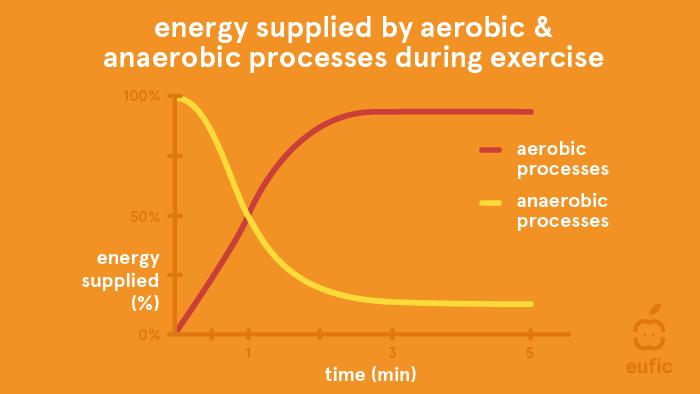The difference between aerobic and anaerobic exercise
Last Updated : 19 February 2021Regular exercise has been consistently shown to benefit both body and mind, as well as reducing the risk of several diseases. It’s beneficial for our health in different ways, and most national dietary guidelines recommend physical activity among other healthy lifestyle recommendations. A balanced exercise routine should aim to include all types of exercise. However, factors such as age, physical fitness or disabilities and personal goals can impact the amount, intensity and type of exercise that is achievable. Remember that any type or amount of physical activity is much better than nothing.
Types of exercises are often grouped into four different categories; aerobic, anaerobic flexibility and mobility, and balance and coordination.1 While some exercises may predominantly fit into one category, many activities will be associated with more than one. For example, many endurance (aerobic) activities such as running, swimming and skiing will also build muscle strength, and some strength (anaerobic) exercises such as HIIT (High Intensity Interval Training) or weight lifting may also help improve balance and mobility. All types of exercise will benefit your health. However, not all types have the same effect on the body. By including all four forms of exercise into your weekly routine, you can increase the benefits to your health.
What is the difference between aerobic and anaerobic exercise?
The human body needs a continuous supply of energy to perform all daily activities and functions, which it does by transforming food to energy. The energy from food that is not immediately used is stored in the body, for example as fat or glycogen. The body has different processes for releasing energy and adapting to the energy needs of different situations, whether it is chopping vegetables or running a marathon. Some of the processes are ‘aerobic’, where ‘aer’ refers to the use of oxygen in the muscles’ energy-generating process. Other processes are ‘anaerobic’ and don’t require oxygen to release the energy. Depending on the duration and intensity of any type of physical activity, our body needs to generate energy in the most effective way, and the aerobic and anaerobic processes often complement each other.
Whether the energy we need during exercise comes from aerobic or anaerobic processes depends on the intensity, duration and types of muscle fibres used.2 When we do anaerobic exercises, our body works intensely over a short period of time and therefore needs energy fast. This energy comes from components that are already stored in our body and are readily available. This process doesn’t require oxygen, but the amount of energy that can be released this way is quite limited.3
The aerobic system is slower than the anaerobic system since oxygen must reach the muscles through our circulation prior to the release of energy. During aerobic exercises, which are less intense but last longer, our lungs and heart work hard to supply oxygen to the body. The body uses this oxygen to break down energy sources like fats and glucose to release energy we can use to perform the exercise. In general, aerobic processes use the oxygen to produce more energy than anaerobic processes, but anaerobic processes release energy faster.4
It can be good to think of aerobic and anaerobic exercises on a scale from ‘mostly aerobic’ to ‘mostly anaerobic’, instead of a clear line between the two.5 Also, many sports involve a mix of both types, for example mostly aerobic walking and jogging with short bursts of mostly anaerobic sprinting. The exact energy contribution to the total energy demand is also individual and can be influenced by factors such as amount of regular training and our diet.6

Figure 1: During exercise, our body releases energy via aerobic or anaerobic processes. The intensity and duration of the activity determine which process supplies the most energy. The exact energy contribution is however individual and can be influenced by factors such as amount of training and diet composition.6
Aerobic (endurance) exercise
Definition of aerobic exercise
In what is usually categorised as an aerobic exercise, aerobic processes dominate in the release of energy that the body can use to perform. Aerobic exercise is often referred to as endurance or cardio exercise and happens when the large muscles in the body move in a rhythmic manner for a long period of time.1 Aerobic exercise involves increasing oxygen consumption by the body. Our body does this by increasing the breathing and heart rate. This kind of exercise is important for many body functions and helps keep our heart, lungs and circulatory system healthy, as well as improving our cardiorespiratory fitness.
Examples of aerobic exercise
Walking, running, cycling and swimming are examples of aerobic exercise.
Aerobic activity can be performed at a range of intensities over a period of time:7
- Moderately intense activities will increase your breathing and heart rate, but you should still be able to carry out a conversation. It will also lead to an increase in body temperature causing slight sweating. If you would be able to talk, but not sing, you know you are working at a moderate intensity level. An example would be brisk walking or casual cycling.
- Vigorously intense activities will lead to heavy breathing where you cannot keep a conversation. It will cause a large increase in heart rate and body temperature. An example would be jogging or circuit training.
Benefits of aerobic exercise
Regular aerobic exercise has been shown to reduce the risk of developing many diseases, such as heart disease, stroke, type 2 diabetes, dementia and even some cancers. Physical activity in general has also been shown to reduce the risk of depression.1
Anaerobic (strength and power) exercise
Definition of anaerobic exercise
In what is often categorised as anaerobic exercise, anaerobic processes dominate in releasing energy that the body can use to perform. Anaerobic exercise, such as strength and power training, will enhance our muscle power, strength and size. This includes performing exercises at high intensity over a short duration, usually on a scale of seconds to a few minutes.
Examples of anaerobic exercise
Sprinting, lifting weights (free weights or resistant machines), resistance band exercises, and bodyweight exercises (e.g. push-ups, pull-ups, squats, lunges) are examples of anaerobic exercise.
Benefits of anaerobic exercise
Regular anaerobic exercise increases our bone mass density, slowing the natural loss of bone that occurs with age and thus reducing the risk of osteoporosis. Maintaining muscle mass is particularly important for older adults, as a decrease in muscle strength can lead to a lack of mobility and increases the risk of falls. Regular resistance training can improve muscle strength.1
Aerobic vs anaerobic: which is best?
Both aerobic and anaerobic exercise is important for optimal health. Aerobic exercise will mainly increase our cardiovascular endurance, while anaerobic exercise will mainly increase our muscle strength.8,9 The World Health Organization recommends doing both aerobic and anaerobic exercise over the period of a week. Their general recommendations for healthy adults aged 18-64 years include:1
- A minimum of at least 150 minutes of moderate-intensity aerobic physical activity throughout the week or at least 75 minutes of vigorous-intensity aerobic physical activity throughout the week or an equivalent combination of moderate- and vigorous-intensity activity.
- Aerobic activities should be performed in bouts of at least 10 minutes duration.
- Additional health benefits, such as even further improvement of bone health and muscular and cardiorespiratory fitness and reduction of the risk of noncommunicable diseases and depression, can be obtained with more exercise. Adults should aim to increase their moderate-intensity aerobic physical activity to 300 minutes per week, or 150 minutes of vigorous-intensity aerobic physical activity per week. An equivalent combination of both moderate- and vigorous-intensity activity is also an option.
- Muscle-strengthening or anaerobic activities should be done involving all major muscle groups (legs, hips, back, abdomen, chest, shoulders and arms) on two or more days a week.
For adults over 65 years, the recommendations are the same as the ones listed for the age group 18-64 years. For people over 65 years, it is additionally recommended that those with poor mobility should perform physical activity to enhance balance and prevent falls on three or more days per week.
For people who are not able to reach the recommended amounts of physical activity due to health conditions, they should be as physically active as their abilities and conditions allow.1
If you want to start doing regular exercise, have questions about what is recommended for you or how you can reach the recommendations, it can be a good idea to contact your GP (general practitioner) or other healthcare professionals who will be able to guide you to a program this is suitable for you. And remember, any type or amount of physical activity is much better than nothing.
Further reading
For a more detailed article, see Physical activity and health.
References
- World Health Organization (WHO). Global recommendations on physical activity for health. 2010.
- Patel, H., et al., Aerobic vs anaerobic exercise training effects on the cardiovascular system. World journal of cardiology, 2017. 9(2): p. 134-138.
- Kent, M., The Oxford Dictionary of Sports Science & Medicine, 3rd ed. 2007: Oxford University Press.
- Hargreaves, M. and L.L. Spriet, Skeletal muscle energy metabolism during exercise. Nature Metabolism, 2020. 2(9): p. 817-828.
- Chamari, K. and J. Padulo, ‘Aerobic’ and ‘Anaerobic’ terms used in exercise physiology: a critical terminology reflection. Sports Medicine - Open, 2015. 1(1): p. 9.
- Geelen, S., et al., Lipid Metabolism in Equines Fed a Fat-Rich Diet. International journal for vitamin and nutrition research. Internationale Zeitschrift für Vitamin- und Ernährungsforschung. Journal international de vitaminologie et de nutrition, 2000. 70
- National Health Service (NHS). Exercise. 2019.
- Wilmore, J., Aerobic Exercise and Endurance Improving Fitness for Health Benefits. The Physician and sportsmedicine, 2003. 31: p. 45-51.
- de Vos, N., et al., Optimal Load for Increasing Muscle Power During Explosive Resistance Training in Older Adults. The journals of gerontology. Series A, Biological sciences and medical sciences, 2005. 60: p. 638-47.



